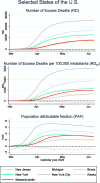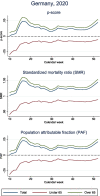Quantifying and communicating the burden of COVID-19
- PMID: 34376146
- PMCID: PMC8353440
- DOI: 10.1186/s12874-021-01349-z
Quantifying and communicating the burden of COVID-19
Abstract
Background: An essential aspect of preventing further COVID-19 outbreaks and to learn for future pandemics is the evaluation of different political strategies, which aim at reducing transmission of and mortality due to COVID-19. One important aspect in this context is the comparison of attributable mortality.
Methods: We give a comprehensive overview of six epidemiological measures that are used to quantify COVID-19 attributable mortality (p-score, standardized mortality ratio, absolute number of excess deaths, per capita rate, z-score and the population attributable fraction).
Results: By defining the six measures based on observed and expected deaths, we explain their relationship. Moreover, three publicly available data examples serve to illustrate the interpretational strengths and weaknesses of the various measures. Finally, we give recommendation which measures are suitable for an evaluation of public health strategies against COVID-19. The R code to reproduce the results is available as online supplementary material.
Conclusion: The number of excess deaths should be always reported together with the population attributable fraction, the p-score or the standardized mortality ratio instead of a per capita rate. For a complete picture of COVID-19 attributable mortality, quantifying and communicating its relative burden also to a lay audience is of major importance.
Keywords: Excess deaths; P-score; Per capita rate; Population attributable fraction; Preventable deaths; SARS-CoV-2; Standardized mortality ratio; Z-score.
© 2021. The Author(s).
Conflict of interest statement
None.
Figures


References
-
- von Cube M, Timsit J-F, Schumacher M, Motschall E, Schumacher M. On the reporting and interpretation of attributable deaths - A systematic review of attributable mortality in core clinical journals on infectious diseases. Lancet Infect Dis. 2020;20(12):E299–E306. doi: 10.1016/S1473-3099(20)30485-0. - DOI - PubMed
-
- Pulla P. What counts as a covid-19 death? BMJ. 2020;370:m2859. - PubMed
Publication types
MeSH terms
LinkOut - more resources
Full Text Sources
Medical
Miscellaneous

